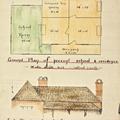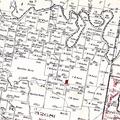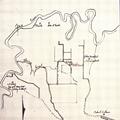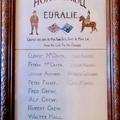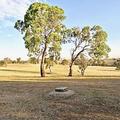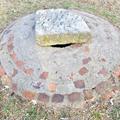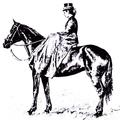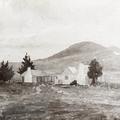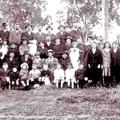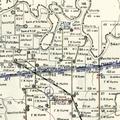< Early Canberra Government Schools
Euralie [1873 - 1929]
Previous Name/s: Spring Creek
Eurolie Station
As a reward for finding a new route over the Blue Mountains in 1827, Hamilton Hume received a grant of 1,280 acres at Yass, which he named Eurolie (later Euralie). Then in 1829 he received another grant of 1,920 acres at Yass, for an expedition of the Macquarie and Darling Rivers with Charles Sturt. He later purchased a large area adjoining these properties, and when he died in 1873 he owned a vast run of 18,000 acres of the finest wool-producing country in Australia.
Eurolie Station was home to three generations of the Hume family. Offered for sale in 1928 as 'Euralie Estate', it was reduced in size by then to 7,500 acres through ownership changes and free selection. The property's gate was 15 km southwest of Yass on Euralie Road, adjacent to the Yass River. It had a fine, slate-roofed brick homestead and various outbuildings including a full time public school.
Early schooling at Euralie
For some years prior to 1873, local children were privately taught in a building 100m west of Euralie's mailbox, on a free selector's block belonging to William Hingerty. On 10th May 1873, the Council of Education received an application to provide aid for this provisional school, called Spring Creek. The application's signatories were Reverend John Gallagher, Thomas Duffy, William Hall and John English. It was submitted that 37 children within two miles, aged between 4 and 14, would attend. John O'Sullivan was nominated as teacher.
(For all Dept. of Educ. references: 'Euralie School', 5/15851.3, NSW Records)
Inspector DS Hicks supported the application provided a suitably furnished building was made available, and that O'Sullivan complete a teaching course for one month at Yass Catholic Boys' School. The Department approved the application on 4th August 1873, and heard from Reverend Gallagher on 15th October that a wooden building of the dimensions recommended by Inspector Hicks had been erected and would be furnished as required. At the end of October, Spring Creek Provisional School formally opened with John O'Sullivan as teacher.
Joseph Kelly replaced O'Sullivan as teacher at Spring Creek School in February 1877 and continued as teacher after it became a public school in December that year. He attained the higher 3B Certificate qualification through after-school training at St Clemens School, Yass, tutored by James Brierly – later the headmaster of Yass Public School, 1879-93.
Euralie Public School, 1879-95
The Council of Education replaced the old slab-built schoolroom with a brick school and residence in 1879. The new building had a shingle roof, schoolroom 22 x 14ft in size with four windows and a fireplace, and a compact two-roomed residence. A verandah, 4ft 6ins wide, spanned the front (see plan below). In April 1883, the Yass school inspector, Mr LE Lawford, recommended that the school's name be changed to 'Euralie', as it was located on Euralie station and there was no creek within two miles of the school. The Minister approved this change on 1st May 1883.
As the school's water tank was inadequate, tenders were invited for a well to be sunk and weather shed built in August 1883. The work, first estimated to cost ₤64 pounds, was eventually completed by John Colls at a much higher cost of ₤134/12/6, as on his advice there was little chance of a spring below, so an underground tank was built instead of a well.
In 1885 Joseph Kelly, a married man with several children, took the unwise step of adding a two-room addition to the residence without Departmental approval. He did it cheaply by recycling slabs from the old school and roofing it in iron, then reported the work to Inspector Lawford at Yass. Lawford noted the incorrect procedure, but praised Kelly for his initiative, recommending that he be remunerated the modest price of ₤9/12/- for his materials, as he had added at least ₤20 value to the building. When brought to a chief inspector's attention however, the outlay was opposed on grounds that 'an extremely dangerous precedent' would be set should any payment be made for unauthorised work. The under secretary's final decision granted payment – but included a stern caution that the teacher shouldn't act similarly in future.
When Joseph Kelly left Euralie School at the end of April 1886, James McCutcheon replaced him. Married with a child, McCutcheon moved into the residence, but soon caused consternation when he, too, carried out some unauthorised work. Having the school clock repaired for 8/6 was not too serious, but having the leaking underground tank repaired for ₤10/10/- resulted in a stern warning from Inspector Lawford that prior authorisation must always be obtained. The next year, McCutcheon made sure he obtained prior approval to fix some ceiling leaks, and being instructed that the repairs must not exceed ₤9 pounds, he managed to have them done for ₤6/10/-.
Mrs Frances Patterson, a married woman with a child, replaced McCutcheon in March 1889. However Mrs Paterson's stay was short after her pupil attendance returns were suspected as having unusually high averages for the number of pupils enrolled. On visiting the school, Inspector Lawford detected undeniable falsification on Mrs Paterson's part - to retain the school's classification (based on average pupil attendance) and her salary level. She was allowed to resign from 31 October 1889.
The next teacher Henry Peck, also married, moved into the school residence after Mrs Paterson and her family departed. The next month, a feature article in the Australian Town & Country Journal reported that Mrs Peck was a notable horsewoman who had recently won first prizes at the Temora Show for best dress, best lady rider and best contestant in the ladies' jumping match (30/11/1889 - illustration below). When their first child was born in January 1891, Mr Peck applied for her to be allowed a week's accouchement leave from her position as sewing teacher. They had two more children in a little over two years.
Early in 1895, Henry Peck received an adverse school report from the new school inspector at Yass, Patrick Sheehy. Called upon to explain deficiencies in his teaching, Mr Peck said that his pupils had various learning difficulties, and that his ability to teach singing was restricted by a chronic throat and lung condition. However this failed to alter the inspector's view that Henry's teaching standards would need to improve substantially to avoid demotion: -
Most of Mr Peck's explanation is devoted to his omitting to teach singing to the first and second classes. He has failed to account for the low results in reading, poetry, dictation, arithmetic, grammar and Scripture in his third class... no piece of poetry was, it would appear, committed to memory by the pupils since last inspection, and only the mark Bad would be awarded for the only piece which they could attempt.
I recommend that Mr Peck be informed that his explanation is not satisfactory, and that he be warned that unless better results are obtained at the next inspection of his school more serious action will have to be taken.
Due to declining pupil enrolments, Henry Peck was transferred to 'The Rock' public school in May 1895. Euralie was closed and stayed so for five years, during which the residence was rented for 1/- a week to George Crew, a cook at Euralie station. A move to reopen the school was led by Henry Dodds - a prominent citizen on the Yass School Board and former Yass mayor. Dodds accepted the lack of pupils for Euralie to operate full-time, and suggested instead it become a half-time school with Warham, which was in the same situation regarding pupils.
Euralie Provisional School, 1900-29
Information about the families at Euralie was given to Inspector Sheehy, who filled out a formal application. It indicated that 14 children could attend from six families: William Hall, EC, 'farmer and selector', could enrol Norman 13, Florence 11, Cyril 9, Walter 6 and Ethel 4; P. M. Bourke, RC, 'farmer and selector': Grace 11, Daisy 8 and John 6; P. Collins, EC, 'selector and carrier': Bartholomew 12, Frederick 7 and Norman 5; John McGrath, RC, 'farmer and shearer': Clement 4; Elizabeth Crew, EC, 'husband, cook at Station': Alfred 4; May Lambert, RC, 'house keeper 6 years at Mr Venables place': May 11. (EC being Church of England in religion and RC, Roman Catholic.)
Approval granted, Euralie reopened as a half-time school with Warham in July 1900. Warham's teacher Mrs Emily Clark then taught both schools a half-week each for 18 months before Warham became closed for want of pupils in December 1901. By this time Euralie's pupil numbers had recovered sufficiently to be full-time again, and Mrs Clark continued as teacher there until March 1907.
In her first winter at the school, Mrs Clark obtained permission to close the school a half-hour earlier at 3.30 pm by shortening the lunch break so the children could be home before dark. Also approved was a month's accouchement leave after she had a baby on 27th January 1901. The school residence was rented out to the Crew family until 1901, but after they vacated the premises in May that year, Mrs Clark and family were able to move in. By this time the school and residence were in much need of renovation, and a tender for ₤9/18/- from Yass builders Thompson & Bales was accepted in March 1901 - for repairs to the windows, flooring boards, verandah posts and out houses.
In July 1903 Emily Clark was granted six weeks leave to nurse her infant daughter who had contracted scarlet fever. Fortunately, the child recovered. In September 1904 Mrs Clark obtained another accouchement leave of one month, for her second child. The next year, she was granted this practical request to pasture her horse at school: -
Sir, I have the honor most respectfully to apply for permission to cultivate about ½ an acre of the school ground. The portion I wish to cultivate is at the bottom of the school ground and measures one chain by 4.1 chains. The area of school ground is 2 acres. The school children never play down in the lower end of the school ground as there is no shade tree in the summer & the grass is too wet in the winter.
I wish to put barley in, in order to provide green stuff for my horse for the winter. I enclose a plan of school ground showing portion I wish to cultivate.
I have the honor... [etc], Mrs Emily Clark, Teacher
During 1906, the school's pupil enrolment declined below the quota required for full-time operation. In December, Euralie had 10 pupils and the small bush school at Derringullen, four miles away, had 11. To avoid both closing, it was suggested that the schools operate half-time sharing one teacher, which took a few months to be approved. Euralie was closed for three months, March-May 1907, during which Emily Clark was moved to Wee Jasper School. Then in June, William Parick Faulder was appointed to Euralie and Derringullen half-time schools.
Mr Faulder, 37 and married, was a well-respected teacher of long experience in small bush schools near Yass. He had met and married Isabella Walker whilst teaching at nearby Ledgerton School in 1898. He taught at Euralie four years then transferred after promotion - as reported by The Yass Courier: 'The promotion of Mr W.P. Faulder to the Oaks, Picton, means the loss to this district of a straightgoing citizen. ... excellent reports at different inspections have led to the present appointment. Our best wishes go with Mr and Mrs Faulder.' (28th August 1911)
Alfred George, married with children, replaced Mr Faulder in August 1911. He took up board at Derringullen and taught a half-week about between the two schools - riding eight miles a day on the return trip to Euralie, doubling his eldest child on the horse. Applying for an extra forage allowance, he reported the difficulty of his ride, which involved crossing the Yass River: -
My horse is in constant work, having to travel every day, and further I have to convey my child over the roughest of roads, merely a bush track. Shoeing cost 5s a set for 10 sets and total 2 pounds 10/-.
In October 1914, Mr George obtained permission to close Euralie School for a week as the Crew family occupying the residence had been in contact with a smallpox patient. The school and residence were disinfected and no one developed the disease. School numbers were increasing again by this time, sufficient for Euralie to be made full-time in February 1913. As a result Derringullen closed and some of its pupils transferred to Euralie, increasing its enrolment to 27 by November 1914.
The War years
Percy Howarth, who replaced Mr George in February 1915, elected to board at Derringullen, making the five-mile trip to Euralie by motorbike. On at least two occasions, he didn't get to school due to mechanical breakdowns on the way. However, as he left the school after only three months, this resolved the problem.
Peter Fraser, who replaced Mr Howarth, revived the school's picnics after their absence for some years; to the delight of the whole community reported The Yass Courier:
Judging by the success that attended the efforts of the head teacher (Mr P. J. Fraser) it should develop into an annual function. For there is no doubt the little ones thoroughly enjoyed themselves, and the elders were in no way behind.
(25 November 1915)
Mr Fraser, finding the school residence almost uninhabitable due to its disrepair, chose to board on a property five miles from the school. Reporting on the poor state of both the residence and the school, he listed the need for a new roof, repairs to the collapsing brickwork, windows, walls and ceilings; urgent work on the verandah - 'likely to tumble down at any time'; re-boarding the weather shed; and better lavatories with wash basins.
Following inspection by a Department of Works officer from Goulburn, the estimated cost of repairs was ₤206. An alternative, cheaper option was to demolish the residence for ₤25, sell the materials and repair only the schoolhouse for ₤90. The latter course was initially recommended but stalled after a further report warned that the school might collapse in the process. Tenders were then invited for the least expensive repairs needed to preserve the main schoolroom. (Government spending being restricted due to the war.)
The war had a marked influence on Euralie's community and school. Almost every young man who enlisted was a former pupil, and the community waited anxiously to hear if they'd survived unscathed. In March 1916, when Mr Fraser enlisted, he was farewelled with an engraved gold medal, presented during a special evening gathering at the school. In July 1918, there was a large attendance at the school to unveil an honour roll made by the teacher, Clarence Selden (Fraser's temporary replacement), of all ex-pupils who had served in the war. In August 1919, every pupil was presented with a Victory Medal; and in November the whole community turned out to welcome home their gallant teacher, Lieutenant Peter Fraser - as The Yass Courier reported: -
... Euralie School was gaily decorated with Allied flags to welcome home Lieut. P.J. Fraser, who some years ago had charge of this school. ...The chairman then called on Mr C. Lawrence to present Lieut. Fraser with a gold medal, suitably inscribed, and a wallet. Lieut. Fraser, who on rising was loudly applauded, thanked his Euralie friends, and assured them that wherever he was destined to be he would always treasure these gifts. (27 November 1919).
Fraser subsequently moved around a lot between Parramatta, Nambucca and Warner's Bay, and finally to Ballina where he died in 1962, aged 69 or 70. Over the years he had been active in the Teacher's Federation.
In July 1918 the community had gathered for the unveiling of the Euralie Public School Honour Roll which listed twelve men, two of whom lost their lives.
Before Clarence Selden was appointed, a relieving teacher named D'Arcy Nolan filled in for three months. Mr Nolan's service at the school, also his teaching career, abruptly ended after an unfortunate incident. Instructed to explain the matter, he sent the following account to Inspector Lewis Henry at Yass: -
I forward a report on the alleged unlawful assault on John bell – a half cast aboriginal. At 11am on the 31st ult a girl who rides to school complained that Bell had frightened her horse by hiding behind the gatepost and springing out as she passed by – this was his third offence. I had reprimanded Bell on former occasions but had not inflicted corporal punishment and had no intention of doing so on that occasion. On reaching the school Bell refused to speak when asked a question. I then told him that unless he answered I would be compelled to punish him and on hearing this he gave a scream and bolted out the door. I followed him. Whilst running the boy fell and refusing to get up I caught hold of him, when he immediately caught my fingers in his teeth and then fastened his teeth in the sleeve of my coat.
Having the cane in my hand I gave him three cuts on the buttock. The boy was not punished for his conduct after school but for absconding and biting.
D'Arcy Nolan appeared in Yass Court on 16th June 1916 to answer a charge of 'unlawfully assaulting John Bell, a boy 7 years of age, contrary to the Act in such cases'. Found guilty of excessively caning the boy, he was fined ₤6/1/- and tendered his resignation on 21st June.
Clarence Selden had a difficult year as Euralie's teacher between June 1916 and his departure in August 1917. For months his teaching was disrupted by noise from the school being repaired and the residence demolished, and for a time lessons had to be conducted in the weathershed. He also had a few periods of sick leave, partly from the strain of riding to school in all weather from his lodging some miles away.
After Mr Selden left, the Department could not guarantee when he would be replaced due to a shortage of male teachers during the war and no board being offered a reasonable distance from the school. In frustration one of the parents, Mrs J. Crocker, wrote to Inspector Henry that the school had been closed 17 weeks during 1917; she concluded her letter, 'I wish to ask if you could possibly send us a teacher'. Months passed before Miss LM King was finally appointed to commence duty in January 1918 - boarding with Mrs Crocker.
A return completed by Miss King lists the following parents as having pupils at the school: 'R McKinnon, E Merritt, Annie M Lawrence, C Lawrence, R Bliss, J Crocker and J J McGrath'. Complaining about the school's dilapidated state in 1916, John McGrath had written to the MLA for Yass, JJ McGirr, giving this vivid description of the school and, more broadly, the growing impact of the War: -
.... I can give you the history of it as it was built when I was a boy, what education I received was inside its walls. It was built in 1879 of brick with shingle roof all the money spent since then has been very trifling. The shingles are rotten spouting is in the same state both leak, verandah of residence is tumbling down. There is an underground tank and at one time the earthen pipes to carry water into it were broken and rabbits used to live in them and at times of poisoning would go there and die and be washed into the tank, a short time ago there was no drinking water for the pupils they having to take it from home and walk as far as three miles. The present teacher is boarding with one of the parents so that you will see from this that it is deserving of attention. I am sorry to be troubling you at so critical a stage. I fully recognise that the Government have an unenviable time. One of my boys is at present in Liverpool camp getting in form to lend those gallant lads a helping hand with their hard struggle.
Two of John McGrath's sons had enlisted to serve in the war. At the time of writing this letter, he and his wife had not long learned that their eldest son, Clement, had been killed in action in France. In March 1919, there was a big gathering at the school to welcome home their second eldest son, Private Patrick McGrath. He was presented with a gold medal and wallet from the community, and a set of military brushes from the pupils. (The Yass Courier, 27 March 1919)
The later years
When Miss King was moved to another school in August 1920, the community was informed that the school would be closed due to insufficient pupils. However, after the Yass & District Chamber of Commerce appealed directly to the Department of Education's head office, Miss Bertha Elliot was appointed. Miss Elliot served four years at the school, succeeded over the next five years by Florence Hilder, Margaret Sexton and Audrey Frost,
Throughout this period the school remained full-time, but had steadily declining pupil numbers. In April 1929, the Yass district school inspector reported that there was no likelihood of an increased enrolment as Euralie station had been sold and several of its employees and their families had left the district. He reported the pupil attendance to be 13, averaging 10.7 daily since the beginning of the year.
The decision to close the school was made in October 1929. Parents were informed the teacher had been withdrawn, though if they so decided, a private teacher's salary would be subsidised by the government (a common form of education in small bush communities, parents also providing a schoolroom). When the parents declined this offer, the school furniture was sent to Yass Public School. The building was then sold to John McGrath's younger son, Richard, who undertook to demolish it and clear the site for ₤45.
(Contributed by Keith Amos, former teacher at The Mullion, out of Yass)
"Fifteen kilometres to the south-west of Yass on the Euralie Road stands the mailbox for Euralie homestead. Some 100 metres due west is the site of the long vanished Euralie school, once the centre of a tiny rural community."
anzacportal.dva.gov.au/history/special-features/great-war-memories/euralie-public-school-honour-roll
Location Map
Related Photos
Teachers
- O'Sullivan, Mr John
'Spring Creek', 10/1873 - Kelly, Mr Joseph
'Spring Creek', 02/1877 - 04/1883
05/1883 - 05/1886 - McCutcheon, Mr James William
05/1888 - 02/1889 - Paterson [nee Cameron], Mrs Frances Jane
03/1889 - 10/1889 - Peck, Mr Henry
10/1889 - 05/1895 - Clark (Lynch), Mrs Emily
07/1900 - 03/1907 - Faulder, Mr William Patrick
06/1907 - 08/1911 - George, Mr Alfred Ernest
08/1911 - 02/1915 - Howarth, Mr Percy S D
02/1915 - 05/1915 - Fraser, Mr Peter J
06/1915 - 11/1919 - Nolan, Mr D'Arcy
Relieving, 03/1916 - 06/1916 - Selden, Mr Clarence N
Relieving, 06/1916 - 07/1917 - King, Miss L M
01/1918 - 08/1920 - Elliott, Bertha
09/1920 - 03/1924 - Hilder, Florence
06/1924 - 01/1927 - Sexton, Margaret
01/1927 - 08/1929 - Audrey, Frost
08/1929 - 10/1929
NSW Government schools from 1848
- Euralie (external link)
< Early Canberra Government Schools
If you are able to assist our work of identifying, documenting, and celebrating the early bush schools of the Canberra region, please contact us or .


